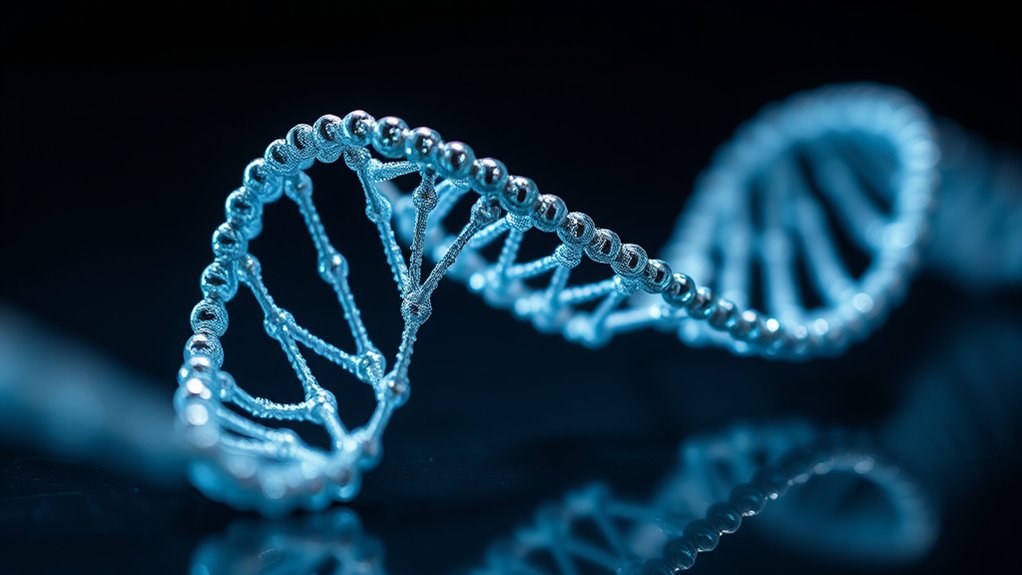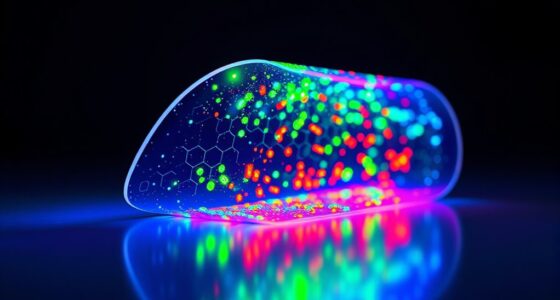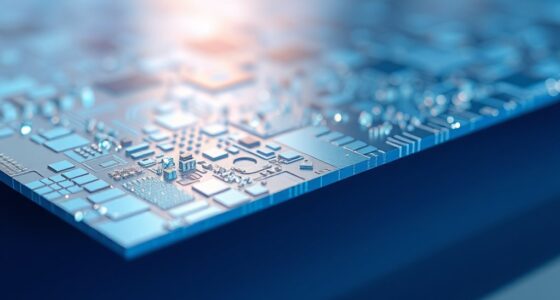DNA origami builds nano-robots by folding a long DNA strand into specific shapes, guided step-by-step by carefully designed base pairs. You select sequences that match precisely, directing the strand to fold into structures with nanometer accuracy. Every base pair acts like a structural or functional building block. With more complex sequence programming, these tiny robots can perform tasks or respond to environments. If you’re curious about how this precise process unfolds, keep exploring further.
Key Takeaways
- DNA origami uses a long scaffold strand folded into precise shapes guided by hundreds of short staple strands.
- Sequence design ensures correct base pairing, directing the scaffold to fold into the desired nano-robot structure.
- Each base pair forms through specific hybridization, gradually building the complex 3D nano-robot.
- Programmable sequences allow for functional elements and dynamic features to be integrated during assembly.
- The process enables construction of nanometer-scale, customizable robots capable of targeted tasks in biological systems.

DNA origami nano-robots are a groundbreaking advancement in nanotechnology, enabling precise manipulation at the molecular level. These tiny machines are constructed with incredible accuracy by folding a long strand of DNA into specific shapes, creating a framework that acts as molecular scaffolding. This scaffolding forms the foundation for the robot’s structure, providing stability and the ability to attach functional components.
As you explore the design process, you’ll see how carefully chosen DNA sequences guide the folding, guaranteeing each base pair aligns perfectly to form the intended shape. This meticulous process allows you to engineer nano-robots capable of performing complex tasks with nanometer precision. Sequence design is a crucial step that ensures the overall accuracy and functionality of the nano-robot.
One of the key advantages of DNA origami nano-robots is their capacity for targeted delivery. Because DNA can be programmed to recognize specific molecular markers, you can design these robots to seek out particular cells or tissues. When introduced into a biological environment, the nano-robots navigate through the body, honing in on their target with remarkable specificity.
This targeted delivery capability opens new horizons for medical applications, such as delivering drugs directly to cancer cells while sparing healthy tissue. The DNA structure acts as a carrier, encapsulating therapeutic agents and releasing them only upon reaching the designated site, reducing side effects and increasing treatment efficacy.
The process involves attaching functional elements—like enzymes, fluorescent tags, or drug molecules—to the DNA scaffold at precise locations. This integration ensures that the nano-robot performs its intended function once it reaches its target.
You can also incorporate dynamic features, such as hinges or switches, into the DNA design, allowing the robot to respond to environmental cues or interact with its surroundings. As you assemble these components, you harness the programmability of DNA to create nano-robots that aren’t only accurate but also adaptable.
Design dynamic DNA features like hinges and switches for adaptable, responsive nano-robots.
In addition, recent advancements in molecular programming enable the creation of more sophisticated and responsive nano-robots capable of complex decision-making processes. As you assemble these components, you harness the programmability of DNA to create nano-robots that aren’t only accurate but also adaptable.
In essence, DNA origami provides you with a versatile platform to build nano-robots that can carry out targeted delivery with unmatched precision. The ability to control their structure at the level of individual base pairs means you can tailor each robot to specific tasks and environments.
This fusion of molecular scaffolding and targeted delivery capabilities is pushing the boundaries of what nanotechnology can achieve, paving the way for revolutionary advances in medicine, diagnostics, and materials science.
As you continue to refine this technology, you’ll open new possibilities for designing nano-robots that operate seamlessly within complex biological systems, transforming the way we approach treatment and analysis at the smallest scales.
Frequently Asked Questions
How Durable Are DNA Origami Nano-Robots in Biological Environments?
You might wonder about the durability of DNA origami nano-robots in biological environments. They face biocompatibility concerns and can be sensitive to environmental stability, which affects their lifespan.
While they’re designed to withstand some biological conditions, factors like enzymes and temperature can degrade them over time. Researchers are working on modifications to improve their stability, but current nano-robots still have limited durability in complex biological settings.
Can DNA Origami Nano-Robots Be Programmed for Specific Tasks?
You can program DNA origami nano-robots for specific tasks through molecular programming, enabling precise control over their actions. By designing the DNA sequences, you dictate how they respond to environmental cues or target molecules, ensuring task specificity.
This customization allows the nano-robots to perform functions like drug delivery, sensing, or repair, making them highly adaptable tools for various biomedical and nanotechnological applications.
What Are the Potential Medical Applications of DNA Nano-Robots?
Imagine a future where you harness DNA nano-robots for medicine. These tiny machines could revolutionize genetic therapy by precisely editing faulty genes, or deliver targeted drugs directly to diseased cells, minimizing side effects.
The potential is staggering—these nano-robots could navigate your body, address health issues at their source, and transform treatment protocols. It’s a groundbreaking frontier, where science fiction becomes reality, one carefully programmed base pair at a time.
How Scalable Is the Production of DNA Origami Nano-Robots?
You might wonder about the manufacturing scalability of DNA origami nano-robots. Currently, mass production faces challenges due to complex synthesis processes and high costs.
However, advances in automated synthesis and scalable assembly techniques are improving manufacturing scalability. With continued research, you’ll see more efficient methods emerge, making large-scale production feasible.
This progress will accelerate the development and application of DNA nano-robots in medicine and technology.
Are DNA Nano-Robots Safe for Use in Humans?
You’re really asking if DNA nano-robots are safe for humans, and it’s a question that’s still in the early innings. While scientists are exploring their potential, concerns about genetic modification and ethical issues remain.
You need to stay informed, as ongoing research aims to guarantee safety and address these concerns. Until then, it’s wise to remember that progress often comes with a fair share of cautious optimism.
Conclusion
Now, imagine holding a tiny robot made of DNA so precise it could fit on a pinhead, yet it can perform tasks like a supercomputer, all built one base pair at a time. You’ve created a nanoscale marvel that could revolutionize medicine, technology, and beyond. This isn’t just science fiction—it’s a microscopic army of DNA origami robots, ready to change the world in ways you’ve never dreamed of, all crafted from the simplest building blocks of life.









